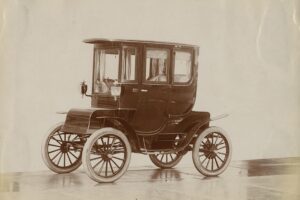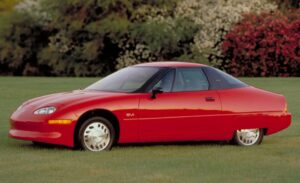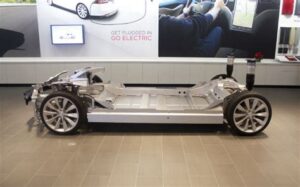In the early 1900’s, well-to-do elderly ladies drove around American cities in small cars powered with electric motors and batteries.These cars were slow and expensive, and since electricity was not yet available in many places they were not always easy to charge. However they were clean, didn’t smell of gasoline or exhaust fumes, and didn’t backfire or make a lot of noise as did the gas powered cars of the time. Also, they didn’t need to be cranked to be started (starters had not yet been invented) and were very simple to operate since they didn’t need to be shifted.

. Electric Car circa. 1910
The electric car was waiting for new technology to be developed that would make it practical and affordable to the modern driver. Before that could happen however, Henry Ford and others made gasoline automobiles and their supporting infrastructure so well-established, inexpensive, dependable, and easy to use that hardly anyone could imagine any other way of doing it.
There has been much talk the last few years about pollution, climate change and how we could benefit by getting rid of gas-burning cars. Cities such as Los Angeles are very prone to air pollution. Other places like Cairo, Bangkok, and Beijing, that not long ago used bicycles as their primary means of transportation, now have swarm after swarm of petrol-powered cars resulting in clouds of life-threatening choking smog.
Sometime around 1990 I read an article in Popular Science magazine about General Motors engineers who were working on a project to build a car that ran on electricity, could be manufactured economically, and be attractive to consumers. I was looking forward to seeing the commercial result of this project and perhaps riding in it, but after several years of waiting I never heard about it again, and I often wondered what had happened.
Later I watched a documentary on Netflix called “ Who Killed The Electric Car “, and there I found what could be a partial answer. According to this video, General Motors had designed an electric 2-passenger coupe that was powered by electric motors and had a range of about 100 miles. They called it the EV1. In 1995 GM built 800 of these and leased them out to various people in California and Arizona for testing.
The video claimed that after several years GM took back all of the cars with no explanation and ran them through a crusher. Many of the testers liked the car and wanted to buy one, but GM would not sell.
There was no further mention of the EV1.

. GM EV1
It was not clear why the GM people changed their minds. They had spent a considerable amount of time and money on this effort. The company never gave a reason for abandoning the project, but there were many theories. Some thought the idea was torpedoed by the oil companies or dealerships who would lose repair business. Others suggested that the car was just too far ahead of the technology available and could not be produced or supported profitably. Still others believed that customer demand was not there due to the short range and lack of charging facilities, and people were just not interested in electric cars since their gas cars were working so well.
However there were some entrepreneurs in California who were very interested.
One of these groups founded Tesla Motors Company in 2001. Their first product was a sports roadster, and later a luxury sedan.
Several years ago while my daughter and I were walking around Easton Town Center in Columbus, OH, we noticed that a Tesla store had recently opened there, so we went in and checked it out. They didn’t have cars as yet – only pictures and models of a thing called a “skateboard”on display. This was a chassis with no body – only motors and a flat platform to hold the batteries. I thought, “Oh boy, here we go again, another EV1”.

. “SkateBoard”
I was very wrong. After many failures, setbacks, and near bankruptcies, Tesla Motors has since become one of the leading electric car manufacturers in the world.
A few years later a Tesla store opened in Eastlake about 40 miles from my residence. They had three actual Tesla cars on display – a Model S luxury sedan, a Model X SUV with gull-wing doors, and a Model 3 sport sedan. A person could actually touch one, sit in one, and perhaps even try it out!
I picked up Byron, a friend and fellow tech enthusiast, and drove to Eastlake to examine this new phenomenon. We talked with Scott, a Tesla employee, and expressed interest in the Model 3. He showed us the features of this model and popped the hood as any good car salesman would do. We expected to see an engine but there was only empty space. He called it the ‘frunk”, and pointed out that you could haul groceries or luggage there. There was no radiator, water pump, spark plugs, valves, push-rods, rocker arms, exhaust system, transmission, carburetor, gas tank, fuel filters, oil, antifreeze – anything associated with a gasoline engine. No oil gauges, tachometer, knobs, or sliders on the dashboard – only a 15 inch iPad.
Scott then showed us how to check the fluid levels. Instead of the expected oil, water, antifreeze, transmission oil, etc, there was only windshield washer fluid.
This was way too simple to work well, we thought, there’s nothing in this thing!
We asked to do a test drive. I slid behind the wheel with Scott as co-pilot and Byron in the back seat.
The very first thing I noticed after putting it in drive is that nothing happened – no noise, jerk, drift or creep – nothing. Oh, I thought , I need to turn it on – but it was on. I pressed the accelerator (I almost said gas pedal!). The car immediately came to life and accelerated smoothly. There was no hesitation or delay as is normal for a gas car, none – only instant reaction. I let up on the pedal and the car slowed down, stopped, and went dead again. “This is ‘one pedal driving’”, Scott pointed out. “You very seldom need to use the brake pedal. When you let up on the accelerator the motor turns into a generator, provides braking, and returns power to the battery”, and then turns off.
Good – less wear on the brakes – and conserves electricity. This feature is impressive but does requires some practice to avoid a jerky ride.
We proceeded to the on-ramp of I-480. Scott invited me to “punch it”. I stomped the pedal and the car took off like a rocket! We were doing over 80mph before we reached the end of the on-ramp.
I heard a “HOLY SHIT”come from the back seat as Byron expressed his surprise and amazement. This was not your grandma’s electric car!
After several more questions I knew I had to have one, so I asked Scott how I could buy it, expecting the usual scene of bartering, threatening, carrying “earnest money” back and forth to the boss, etc, etc.
Scott told me that they did not sell the cars but that I needed to log onto Tesla.com, select the wanted features, order the car, approve the amount, and make a $200 refundable down payment and I would be notified when my Tesla arrived. It would either come to Eastlake or would be delivered to my door, and after examining it thoroughly I could either accept or reject it.
Wow! This was a different car-buying routine than I had ever experienced from any car dealer. I decided to take the plunge.
More to follow.